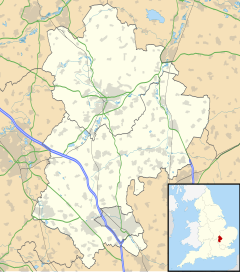Greenfield, Bedfordshire
| Greenfield | |
|---|---|
| Greenfield shown within Bedfordshire | |
| OS grid reference | TL053063 |
| Unitary authority | |
| Ceremonial county | |
| Region | |
| Country | England |
| Sovereign state | United Kingdom |
| Post town | BEDFORD |
| Postcode district | MK45 |
| Dialling code | 01525 |
| Police | Bedfordshire |
| Fire | Bedfordshire and Luton |
| Ambulance | East of England |
| EU Parliament | East of England |
| UK Parliament | |
Greenfield is a small village about 2 km (1.2 mi) from the town of Flitwick in Bedfordshire, England. It lies across Flitwick Moor from the larger settlement of Flitwick and is on the opposite side of the River Flit. It forms part of the parish of Flitton and Greenfield.
The main street (High Street) has junctions with Pulloxhill road, leading to the village of Pulloxhill, School Lane, the site of the old village school. High Street also has a junction with Mill Lane, which was until the 1960s a cart route to Ruxox Farm, Maulden and Ampthill and now leads to footpaths and bridleways to Maggot Moor, Flitwick Moor, Ruxox Farm, Flitton Moor, and the village of Flitton. Houses along High Street are a mix of thatched cottages and Bedfordshire brick dwellings, with an assortment of renovated or rebuilt barn buildings in keeping to some extent with earlier farm courtyard structures.
Due to closures, there is now only one public house in Greenfield called The Compasses. Three former pubs, were the Swan Beerhouse on Mill Lane which closed in 1909, the Nags Head Beerhouse on the High Street which closed in 1913, and the Old Bell Public House which closed more recently in 2007. There was also once a post office and store on Mill Lane, and the village store on the High Street (formerly Cockroft's), and a village school on School Lane that was later used as an artists studio by artist and sculptor James Butler. The former beer houses and stores are now private residences. A new village school was built on Pulloxhill road during the 1960s.
The original agrarian folk community has had a long known history stretching back to the pre-Roman times. Evidence of an ancient settlement has been found on the adjacent woodland mire area of Flitwick Moor. Artifacts can be found in fields and ditches in Greenfield, mainly of flint scrapers and arrowheads from the mesolithic era, and even into the neolithic era and Iron Age due to the useful durable nature of the local flint. Ancient Briton relics respecting the Celtic god of thunder, such as a Wheel of Taranis, have been found at the Ruxox site, which in the 1220s became the Ruxox Cell of Dunstable Priory. Roman artefacts such as tiles, fragments of pots have and an altar to the cult of Bacchus have also been found locally at Ruxox (Hutchison 1986).
During the last decade of the 18th century, field enclosure was introduced, quite late on in history, and riots were instigated by local tenants who gathered to protest as their livelihood was under threat. Further threat to the local folk way of life would also come from the relatively late introduction of Protestant Christian thought in the area. Greenfield was expanded in the 19th century as a Methodist settlement alongside the Church of England settlement at Flitton. Temperance meetings were introduced and organised by newcomer nobility from Wrest park, which led to the demise of two key local beerhouses that served the traditional folk community at the time.
...
Wikipedia

